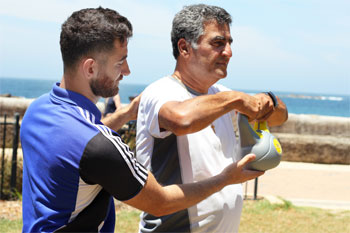Combat Chronic Pain with Exercise

Combat Chronic Pain with Exercise
In conjunction with National Pain Week running from the 24 – 30 July, Exercise & Sports Science Australia (ESSA) are imploring Australians who are living with chronic pain to seek advice on how physical activity, prescribed by an appropriately qualified exercise professional, can make their pain more manageable.
'Currently in Australia, 1 in 5 individuals are affected by chronic pain, or persistent pain. Research has shown that physical activity is an essential aspect in its treatment, specifically when it is delivered by an exercise professional with expert knowledge on chronic conditions," says ESSA Chief Executive Officer, Anita Hobson-Powell.
Although injury is the most common cause for chronic panic (38 percent), other identified causes include musculoskeletal conditions, cancer-related pains or headaches, just to name a few. Research also tells us that a further third of all people who experience chronic pain are actually unable to identify the original cause.
'Chronic pain is continuous, even after healing from an injury. This pain can also affect a person's mental and emotional health by resulting in anxiety, depression, irritability and fatigue. Physical activity can help treat and manage chronic panic, despite what the causation may have been," adds Ms. Hobson-Powell.
When someone is experiencing chronic pain, they tend to avoid activities to not worsen the pain or cause it to flare up. Exercise can be an effective way to reverse the downward cycle of worsening pain, and gradually, over time, help those with chronic pain engage more in activities of enjoyment and complete essential daily living activities with greater ease.
Increased physical activity promotes lubrication of the joints, enabling them to glide easier, strengthens the muscles, and improves your mood. As physical activity produces endorphins, the body's natural painkiller, after a bout of exercise, things hurt less, pain tolerance increases, and these effects can last for up to an hour, depending on the exercise.
'Our bodies are designed for movement. Structures in the body, including the nerves and discs in the spine, need movement to be healthy. In 70-80% of cases, it is possible to manage chronic pain effectively, but despite this, only 10% of those affected are accessing adequate treatment," explains Accredited Exercise Physiologist, Emil Josef.
'It is normal for people with chronic pain to feel anxiety about increasing their physical activity. They may experience discomfort initially, which is why exercise must be prescribed by an appropriately qualified exercise professional who understands your condition and can offer reassurance that this pain does not necessarily equal further injury, and in turn reduces anxiety," notes Mr. Josef
To locate your local accredited exercise professional to help you manage chronic pain, click here
To find out more about exercise and chronic pain, click here
To find out more about National Pain Week, click here
MORE



